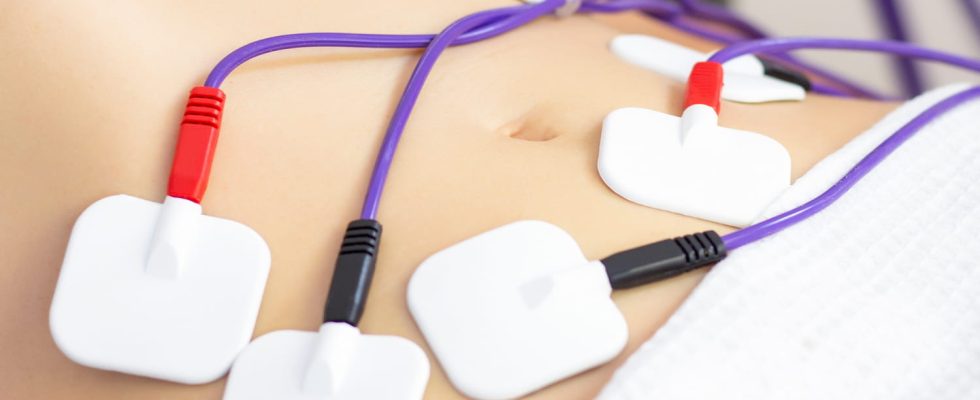Transcutaneous electrical stimulation (TENS) electrically stimulates a muscle or nerve with the aim of relieving (chronic) pain. It is practiced by a physiotherapist. What is the benefit of electrostimulation?
Transcutaneous electrical stimulation (TENS) is a technique whose objective is to relieve pain, and in particular chronic pain. It refers to the fact of applying electrodes on the skin that send electric currents. Electrostimulation covers different therapeutic interests. How works electrostimulation? What are the risks ?
Definition: what is electrostimulation?
Transcutaneous electrical stimulation (TENS) is one of the non-pharmacological and non-invasive methods aimed in particular at relieving pain. She usually uses electric currents applied to the skin. Transcutaneous electrical stimulation devices are typically small, battery-powered, and include two electrodes. Electrodes are cables that send electrical current. (The electrodes are the interface between the skin and the cable). Generally, the two electrodes of the device are connected to the patient’s skin, in the painful area. For long or chronic conditions or if the treatment requires it, the doctor or physiotherapist explains to the patient how to use them, so that he can use them at home.
TENS uses a low voltage electric current transmitted to the nerves by electrodes placed on the skin. Its intensity and the frequency of the pulsations can vary. “There is no risk of electrical burns: it is a “bidirectional zero-average” current. specifies Romain Grivillers, physiotherapist.
What is the benefit of electrostimulation?
“Today, the main use of TENS is chronic pain“explains Romain Grivillers. Chronic pain is a multifactorial syndrome with a significant impact on quality of life. It can be characterized by at least two of the following elements: its persistence (it is constant pain, more three months), insufficient response to treatment, a significant and progressive deterioration of the functional and relational capacities of the patient in his activities of daily living. In this context of chronic pain, the use of an electrostimulation device may be recommended under the following conditions:
- Insufficiency and/or inadequacy of medicinal treatments, in one of the following cases: expected benefit compared to drug risks (related to the site); polypathological ground; intolerance or refusal of drug treatment.
- Presence of a sufficient number of myelinated fibers to be stimulated and patient responding to neurostimulation (pre-trial).
- Motivated patient and having a good ability to adhere to treatment.
- Possibility and ability to train the patient in the technique.
The other use of electrostimulation is rehabilitation of the perineum in case of urinary or faecal incontinence to stimulate and strengthen the pelvic floor muscles. It is then, in the case of urinary incontinence, to insert an electrode in the vagina or the anus. This occurs in particular after pregnancy or childbirth but other situations may exist in women and in men. This technique has the advantage of not requiring voluntary effort from the patient, but as it is a passive pacing, it has the disadvantage of being less effective than techniques where patients actively contract their perineum. “It is therefore of interest to ask an active contraction at the same time as the electrical stimulation, moreover the electrode can in this case serve as feedback“explains the physiotherapist. Other analgesic indications for TENS such as osteoarthritis, arthritis, tendinopathy or cancer-related painto “phantom” pain are not validated today either by the High Authority for Health (HAS), or by the various studies carried out, the evidence being insufficient.
Where to place the electrodes in electrostimulation?
Electrostimulation can be used just as well:
► On the facein particular during dental procedures in order to reduce the discomfort associated with the injection of anesthetic products or to try to relieve the pain associated with the algo-dysfunctional syndrome of the manducatory apparatus.
► On the kneefor example in osteoarthritis, for brief pain relief – it should be noted that studies show no functional improvement in the joint.
► On the belly in case of painful menstruation
► On the lower back for low back pain, although the beneficial effect is thought to be more likely to be placebo
► In the vagina or anus as part of a rehabilitation of the perineum. “Attention, it is not the same mode of operation: it is muscle electrostimulation in this case, it is a question of recruiting the muscle fibers to optimize the muscular work by using the muscular excitability threshold. This is not the case for TENS, which uses Gate control.explains our interlocutor.
In terms of pain management, TENS would work according to two principles:
► Gate control which is based on a principle of pain signal blocking. The stimulation device generates electrical impulses that activate nerve fibers of larger gauge, and faster than those used to convey pain. A tingling message is transmitted to the brain via the spinal cord, and thus masks the pain signal for the duration of the stimulation session.
► Endorphin stimulation which promotes increased production of endorphins. Endorphins are a painkiller naturally secreted in the body. This increase leads to a general painkiller effect.
What are the risks of electrostimulation?
Electrostimulation has few adverse effects: only skin irritations can sometimes happen. Since electrostimulation is a passive treatment, there is a risk to maintain the fear of movement for fear of pain (kinesiophobia) in the patient when active rehabilitation would be more beneficial.
What are the contraindications of electrostimulation?
There are some contraindications to the use of an electrostimulation device:
- wearing implantable electronic devices, including pacemakers
- application on a injured or numb skin area
- the application on the regions: anterior cervical, thoracic and carotid sinuses
- a venous or arterial thrombosis or thrombophlebitis
Regarding electrostimulation in perineal rehabilitationit is contraindicated in case of:
- Recent installation of a IUD.
- Genitourinary cancer.
- Vaginal infection.
- Bleeding period significant menstrual bleeding (menorrhagia or hypermenorrhea).
- Inflammatory hemorrhoids.
- Incontinence extra-urethral or overflow
- Significant urinary retention.
- Absence of pelvic floor innervation.
Thanks to Romain Grivillers, physiotherapist.
